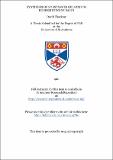Files in this item
Synthesis of substances related to rubrementinum salts
Item metadata
| dc.contributor.advisor | Openshaw, H. T. | |
| dc.contributor.author | Thackray, David | |
| dc.coverage.spatial | 168 p. | en_US |
| dc.date.accessioned | 2018-07-02T09:56:23Z | |
| dc.date.available | 2018-07-02T09:56:23Z | |
| dc.date.issued | 1961 | |
| dc.identifier.uri | https://hdl.handle.net/10023/14780 | |
| dc.description.abstract | In 9152, the evidence available was still insufficient to decide between various structures proposed for the rubrementinium salts. The author has therefore attempted to gather further evidence. The evidence available in the literature is discussed in Part II, and the author’s work in Parts III and IV of this thesis. The substances which the present author has termed rubremetinium salts have more than one name in the literature. Karrer uses the name “dehydroemetin”. Pyman, who discovered the salts, at first used “rubremetine”. It was later found, however, that the salts are quaternary, so Pyman applied to the quaternary ion the name “rubremetinium”. This name will be used throughout the present thesis. | en_US |
| dc.language.iso | en | en_US |
| dc.publisher | University of St Andrews | |
| dc.subject.lcc | QD189.T5 | |
| dc.subject.lcsh | Fused salts | en |
| dc.title | Synthesis of substances related to rubrementinum salts | en_US |
| dc.type | Thesis | en_US |
| dc.contributor.sponsor | University of St Andrews | en_US |
| dc.type.qualificationlevel | Doctoral | en_US |
| dc.type.qualificationname | PhD Doctor of Philosophy | en_US |
| dc.publisher.institution | The University of St Andrews | en_US |
This item appears in the following Collection(s)
Items in the St Andrews Research Repository are protected by copyright, with all rights reserved, unless otherwise indicated.

